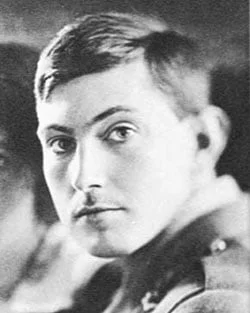Real Celebrities Never Die!
OR
Search For Past Celebrities Whose Birthday You Share

source:.wikipedia.org/
George Mallory
Birthday:
18 Jun, 1886
Date of Death:
09 Jun, 1924
Cause of death:
Mountaineering accident
Nationality:
British
Famous As:
Mountaineer
Age at the time of death:
37
Early Life and Passion for Climbing
George Mallory, born on June 18, 1886, in Mobberley, England, was not destined for an ordinary life. Though he came from a family with generations of clergymen, young Mallory felt a different calling. His passion for adventure, sparked by a teacher’s introduction to the Alps while at Winchester College, would shape his life. Mallory quickly developed his skills, mastering mountain climbing with a growing determination. For him, climbing wasn’t just a hobby; it was a pursuit of human achievement.
World War I and Its Impact
Mallory’s climbing pursuits were put on hold when World War I erupted. He served bravely in the Royal Garrison Artillery, an experience that undoubtedly influenced his perspective on life and mortality. Despite the horrors of war, Mallory’s resolve remained strong. When the war ended in 1919, he returned to England and resumed teaching at Charterhouse School. However, his heart was set on a new challenge—Mount Everest.
The Call of Everest
Mount Everest, the tallest peak in the world, had captured the imagination of adventurers everywhere. Given his experience and fearless spirit, Mallory was a natural choice for the 1921 British reconnaissance expedition. This first trip wasn’t about reaching the summit; it was about understanding the mountain. George Mallory and his close friend, Guy Bullock, played key roles in identifying a potential route on the northern (Tibetan) side, which would lay the groundwork for future attempts.
Subsequent Everest Expeditions
Mallory’s fascination with Everest turned into an obsession. He joined two more expeditions in 1922 and 1924, each time risking life and limb in pursuit of the summit. These expeditions were fraught with extreme weather, dangerous terrain, and primitive equipment. Climbers had limited access to oxygen, and their gear was rudimentary by modern standards. Nevertheless, Mallory’s determination never wavered. His now-famous response to the question, “Why climb Everest?”—“Because it’s there”—epitomized his relentless spirit.
Family Life and Mountaineering
Despite his risky ventures, George Mallory’s personal life was rich and full. He married Ruth Turner in 1914, just before World War I broke out. Their marriage endured both the trials of war and Mallory’s long absences on climbing expeditions. Together, they had three children. But the allure of Everest always pulled Mallory away from home, casting a shadow over his family life. His love for his family was strong, but his need to conquer Everest was irresistible.
George Mallory's Quote's
The 1924 Expedition: Mystery and Legacy
The 1924 Everest expedition would forever cement Mallory’s place in mountaineering history. On June 8 or 9, 1924, Mallory and his climbing partner, Andrew Irvine, made a final push toward the summit. They were last seen by teammates at Camp VI, approximately 800 feet from the top. Tragically, they never returned. Whether they reached the summit or perished before making it remains a mystery.
For over 75 years, their fate was unknown. The discovery of Mallory’s body in 1999 provided some answers, but the question of whether he reached the summit remains unresolved. His death only deepened the legend of George Mallory, whose determination and love for adventure continue to inspire climbers around the world.
A Lasting Legacy
George Mallory’s story is one of passion, adventure, and an unyielding desire to push the boundaries of human achievement. His legacy lives on not only in the annals of mountaineering but also in the spirit of those who challenge themselves to reach new heights.
Name:
George Mallory
Popular Name:
George Mallory
Gender:
Male
Cause of Death:
Mountaineering accident
Spouse:
Place of Birth:
Mobberley, Cheshire, England
Place of Death:
North Face (Everest), Tibet
Occupation / Profession:
Personality Type
Adventurer: Flexible and charming artists, always ready to explore and experience something new .He was an adventurous spirit who had a philosophical approach to life, combined with sensitivity and introspection
During Mallory's 1922 expedition to Mount Everest, he participated in an experiment to use supplemental oxygen at high altitudes, which was a pioneering effort in high-altitude mountaineering.
Mallory's disappearance on Everest in 1924 sparked decades of speculation and debate about whether he and his climbing partner, Andrew Irvine, reached the summit before perishing. The mystery was partially solved in 1999 when Mallory's body was discovered on the mountain, but the question of whether they reached the summit remains unanswered.
Mallory's passion for climbing was ignited during his school days when he joined the mountaineering club at Winchester College. He embarked on his first expeditions to the peaks of Wales and the Lake District during this time.
Mallory was an avid photographer and carried a Vest Pocket Kodak camera with him on his expeditions. His images captured the stunning beauty of the mountains and provided valuable documentation of his climbs.
Mallory made numerous groundbreaking ascents in the Alps and the Himalayas, showcasing his remarkable skill and courage as a mountaineer.
Mallory’s three expeditions to Mount Everest in 1921, 1922, and 1924 marked significant milestones in the history of high-altitude mountaineering.
